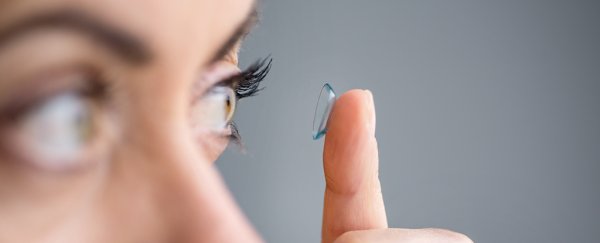Treating wounds on a part of the body as delicate as the eyeball isn't easy, but scientists have developed an innovative new approach: a therapeutic contact lens that can act as a band-aid for damaged eyes.
This is no ordinary contact lens, because it's made up of donor cells left over from regular corneal transplants. These special limbal mesenchymal stromal cells (L-MSC) help to encourage the injured eye to repair its wounds itself.
And according to the researchers behind the idea, a contact lens bandage could be in place within hours of a patient arriving at hospital with eye damage. It's likely to be cheaper and easier to apply than current treatments too.
"Based upon preliminary data we believe that the donor cells release a range of wound-healing factors that encourage repair of the eye's surface," says one of the researchers, Damien Harkin from the Queensland University of Technology (QUT) in Australia.
"Our therapy could provide welcome relief for patients suffering from chronic conditions such as corneal ulcers and persistent surface defects that haven't responded to conventional therapies."
Contact lenses of various types and specifications are already being used to treat eye conditions, in many cases simply covering and lubricating the affected area to allow the eye to heal naturally. They can also fulfil a similar role after surgery.
Under the proposed new approach, L-MSC would be sourced from a donor bank when needed, then applied to a scleral lens – a type of larger contact lens that holds a thin reservoir of fluid between the cornea and the lens.
And while the current types of treatment – amniotic membrane bandages donated from human placentas – can be effective, the membrane takes a while to source and can vary in terms of its healing properties.
 (QUT)
(QUT)
The new method should be faster, less expensive, and more reliable, say the researchers.
It's another in a growing list of clever contact lens uses – including the smart contact lens we saw earlier this year that can monitor glucose levels in tears. While human trials are yet to happen, they could be hugely beneficial to those living with diabetes.
Likewise, these band-aid contact lenses will need to go through an extensive set of clinical trials before they get approved, and the researchers say it could take several years for them to become available to general public.
Nevertheless the early indications are promising, and these special lenses could even end up being used in emergency medical kits to limit eye damage right after an accident.
"The new treatment could also become useful as a part of the first-line therapy in the management of acute eye injuries experienced in the workplace or at home arising from exposure to caustic chemicals, scalding liquids or excessive heat," says Harkin.
The contact lens continues to evolve – but never forget the risks of leaving them in too long.
